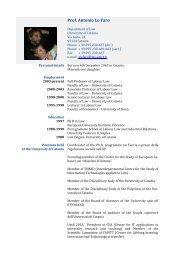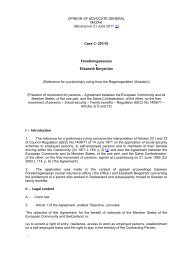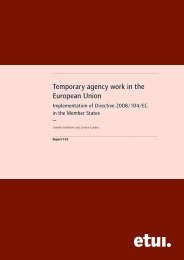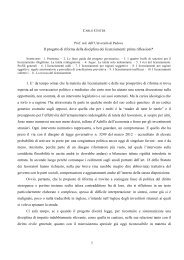Study on non-legislative initiatives for companies to promote gender ...
Study on non-legislative initiatives for companies to promote gender ...
Study on non-legislative initiatives for companies to promote gender ...
Create successful ePaper yourself
Turn your PDF publications into a flip-book with our unique Google optimized e-Paper software.
98 Gender equality <strong>initiatives</strong><br />
Out of these 30 <strong>companies</strong>, 6 multinati<strong>on</strong>al enterprises and 1 SME have been<br />
selected <strong>for</strong> further in-depth analysis. The following presentati<strong>on</strong> summarises key<br />
aspects based <strong>on</strong> brief descripti<strong>on</strong>s of all <strong>initiatives</strong> identified in the 30 <strong>companies</strong> and<br />
<strong>on</strong> the case studies of <strong>companies</strong> selected <strong>for</strong> an in-depth analysis (the in<strong>for</strong>mati<strong>on</strong> in<br />
the boxes refers <strong>to</strong> the <strong>initiatives</strong> of <strong>companies</strong> which have been analysed in detail and<br />
which are fully described in Annex 3).<br />
The <strong>companies</strong> have been carefully chosen. The choice was mainly based <strong>on</strong> expert<br />
recommendati<strong>on</strong>s, company rankings or award winners in (a category related <strong>to</strong>)<br />
<strong>gender</strong> equality at the workplace. A statement such as “most of the <strong>companies</strong> follow a<br />
certain approach”, there<strong>for</strong>e has <strong>to</strong> be unders<strong>to</strong>od in that c<strong>on</strong>text, i. e. the underlying<br />
sample is not a random <strong>on</strong>e but <strong>on</strong>e that has specifically been chosen <strong>to</strong> gain insight<br />
in<strong>to</strong> interesting and innovative practices in the promoti<strong>on</strong> of <strong>gender</strong> equality at the<br />
workplace.<br />
It also has <strong>to</strong> be borne in mind that the <strong>initiatives</strong> described in the following secti<strong>on</strong>s of<br />
this chapter are examples of what <strong>companies</strong> can do in a certain field or – <strong>for</strong> the<br />
more comprehensive approaches – throughout these fields. When stating that a certain<br />
approach is pursued by <strong>on</strong>e specific company, that does not necessarily mean that<br />
other <strong>companies</strong> within this analysis do not implement the same or a similar initiative. It<br />
means that the company/initiative described here has been chosen as an example.<br />
The choice of <strong>initiatives</strong> has been based <strong>on</strong> the innovativeness of the approach and<br />
<strong>on</strong> what the interview partners at the <strong>companies</strong> found important <strong>to</strong> highlight, i. e. which<br />
of their company’s approaches they c<strong>on</strong>sider most important and effective. For<br />
example, <strong>companies</strong> with a comparatively l<strong>on</strong>g-standing traditi<strong>on</strong> in the implementati<strong>on</strong><br />
of flexible work schedules would not have spoken about these practices as their main<br />
approach, but have rather presented their more recent approaches with specific focus<br />
<strong>on</strong> <strong>gender</strong> equality.<br />
Although the <strong>companies</strong> are active in different industries, there are some issues in<br />
relati<strong>on</strong> <strong>to</strong> <strong>gender</strong> equality at the workplace that are not industry-specific (e. g. retenti<strong>on</strong><br />
of women after the birth of children). Other issues, such as <strong>to</strong>o few applicati<strong>on</strong>s from<br />
women are a typical problem of technology intensive industries; while <strong>to</strong> the c<strong>on</strong>trary<br />
the cosmetics industry appears <strong>to</strong> hardly receive applicati<strong>on</strong>s from men as has been<br />
experienced by L´Oréal, <strong>for</strong> example.<br />
From the analysis of the multinati<strong>on</strong>al enterprises it has been interesting <strong>to</strong> learn that,<br />
although there are strategies, programmes, etc. that apply throughout all countries<br />
these are in most cases adapted <strong>to</strong> the specific situati<strong>on</strong> within a country. On the<br />
<strong>on</strong>e hand, this is necessary <strong>to</strong> comply with e. g. nati<strong>on</strong>al labour legislati<strong>on</strong> while <strong>on</strong> the<br />
other hand the company has <strong>to</strong> take nati<strong>on</strong>al culture in<strong>to</strong> account.<br />
Out of the multinati<strong>on</strong>al enterprises that have been analysed in the course of this study<br />
7 have their headquarters in the USA. It has been sought <strong>to</strong> give an “European”<br />
example in these cases, i. e. <strong>to</strong> describe how the global strategy has been enriched<br />
or adapted <strong>to</strong> suit the framework c<strong>on</strong>diti<strong>on</strong>s of a specific country in Europe.
















